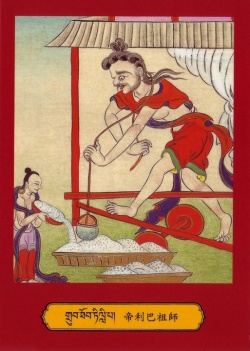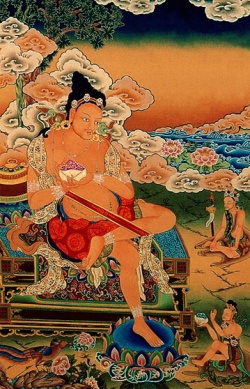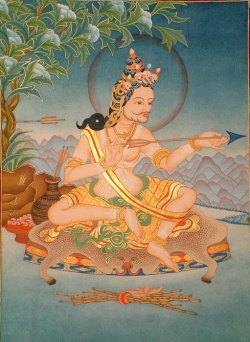Mahasiddha Sri Tilopa
Sri Tilopa was a leading exponent and a yogi-poet of the Sahajiya-yogacara school of Buddhist spiritual practice. He was born in Bengal in 988 AD and is said to have been a member of the Brahmin caste who deserted his caste to live amongst the poor. It is said that originally, as a Brahmin and a Buddhist monk, he was raised to the post of personal priest (purohit) to the King of Visnunagara, in the southern region of West Bengal, India. He was, however, unhappy in that role—a role which he did not feel conducive to the attainment of Enlightenment—and one night, under cover of darkness, he fled away, to take up residence amongst Bengal's caste of fishermen, the poorest of the poor. While residing amongst these Candala folk, he met and ended up living with a prostitute girl named Dharima, who like himself had aspirations towards the spiritual life. To earn a living, Tilopa pounded sesame, producing sesame oil; hence his name, from the Bengali word "til" meaning "sesame". Thus it is said that by day he worked pounding sesame and by night he meditated in the company of Dharima.
While living in that fashion, Tilopa and Dharima eventually attained Great Enlightenment, seeing the Absolute itself face to face. When their fame spread and the people of Bengal gathered to hear what they had to teach, Tilopa and Dharima jointly sang this Vajra Song (vajragita), as follows:
The oil which is the essence of the sesame, although known even by the ignorant to be in the seed, cannot be extracted unless it is learnt how to do so.
Likewise, the Innate Gnosis (sahaja-jnana), though always present in the hearts of beings, is not realized unless the way is explained by a wise Guru.
By pounding the sesame, removing the husks, it is possible to extract the essential oil.
Likewise, when on attends to the Guru's Instruction, the truth of Absolute: (tathata) is revealed.
This is the symbolism of the sesame. Indivisible and one is the Ipseity of all that exists!
0! So vast, so deep, the meaning is now perfectly clear! How wonderful!
The essential message of this song is that, just as the oil is hidden like an essence in the seed of the sesame, so there is in man an innate-essence (sahaja) similarly hidden, namely the Enlightened-mind, which is the Gnosis of the Absolute itself. By following the proper Path, any one of us can come to know this profound and Divine Essence of our own being.
Tilopa studied under a number of different teachers. Therefore, as a practicing yogi and later as a teacher to others, he combined and merged together several lineages of instruction. Two lineages came from supernatural inspiration—these are said to consist of the hidden teaching of the Gnostic Dakini, Vajrayogini, and the direct wisdom of Mahavajradhara, the Absolute itself. Four lineages consist of the lines of oral instruction passed down from the four early saints: Nagarjuna, Caryapa, Lavapa and Subhagini.1
From Matanga a disciple of the Siddha Nagarjuna, who in turn was a disciple of the great Saraha, and also from Sri Nagarjuna himself, Tilopa received the Guhyasamaja-tantra and the secret oral instructions on "Illusory-body" yoga. From Caryapa he received the oral instructions on Dream yoga according to the method of the Mahamaya-tantra. From Lilavajra, a disciple of Lavapa, and from Lavapa himself, he was initiated into the Cakrasamvara-tantra and received the secret oral instructions on the clear Light. Finally, from the woman saint Subhagini, and from her partner Guru Vijaya, he received the complete Candalini-yoga practice according to the system of the Hevajra-dakini-tantra. Sri Tilopa and Dharima combined these four lineages of instruction into a new, single lineage. It is from this that the esoteric Ka'gyu tradition derives its name, for Ka'gyu (spelt bKa.brgyud) is short for the Tibetan "theg. pa. gsum. gyi. snying. don. bka. bab. kyi. chos. bzhi'i. gdams. ngag. bar. ma. chad. pa'i. brgyud.pa", which translates as: "the unbroken transmission (brgyud) and esoteric teachings of the four Doctrines of Oral Instruction (bKa), which form the essential meaning (shying-don, the heart-truth) of the Three Ways [of traditional Buddhism]." Here the term "bKa" is actually understood to mean bKa-bab-bzhi, the four oral Instructions of yogic mastery.
As eloquently said by XII Khentin Tai Situ Rinpoche,
"These four (consisting of an intimate knowledge of mind and three skillful areas of technique), combining to make the Mahamudra practice as a whole, have been transmitted, so very purely and completely, via a lineage of wisdom-masters and perfected students, from the time of Tilopa until our present day. They form the hub of the present Ka'gyu tradition."
This is what we mean when we talk of the Golden Rosary of the Ka'gyu tradition (bKar-brgyud gser'phreng). The father of this whole tradition was Sri Tilopa.
Sri Tilopa's most direct "pointing-out" instruction, his main "pith-instruction" (upadesa) to his leading disciple Mahapandita Nadapada (or "Naropa" as he is commonly known), is encapsulated in a short song or poem, said to have been recited on the banks of the great Ganges river. This is the poem known in Tibet as the Ganga Ma, or otherwise as the Ganga-Mahamudra-upadesa, the "Ganges River Pith-Instruction on Mahamudra."


